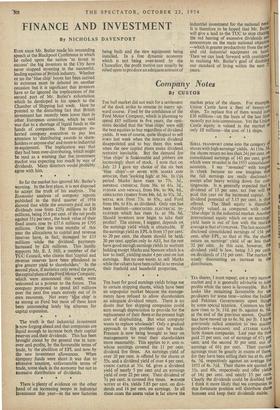Company Notes
By CUSTOS THE bull market did not wait for a settlement of the dock strike to resume its merry up- ward course. Fired by the confidence of the Ford Motor Company, which is planning to spend £65 millions in five years, the opti- mists decided that the 'blue chips' were still the best equities to buy regardless of dividend yields. It was of course, quite illogical to sell FORD last week when the interim dividend disappointed and to buy them this week when the new capital plans make dividend restraint inevitable. But the demand for blue chips' is fashionable and jobbers are increasingly short of stock. I note that on July 23 I gave my choice of the six best ' blue chips'-or seven with MARKS AND SPENCER, then 'looking high' at 54s. In t:iis period Marks have risen to 77s. 3d., IMPERIAL CHEMICAL from 36s. to 41s. 3d., TURNER AND NEWALL from 84s. to 90s. 6d., ASSOCIATED CEMENT from 84s. 6d. to 92s. 3d., METAL BOX from 73s. to 85s., and Ford from 68s. to 83s. ex dividend. Only one has been hesitant-ASSOCIATED ELECTRICAL IN- DUSTRIES which has risen Is. at 58s. 6d. Should investors now begin to take their profits? The answer, I suggest, depends on the earnings yield which is obtainable. If the earnings yield ex EPL is from 15 per cent. to 20 per cent. the shares should be held. 20 per cent. applies only to AEI, but the rest have good enough earnings yields to warrant holding except Marks and Spencer which is a law to itself, yielding under 4 per cent on last earnings. But no one wants to sell Marks while the valuers have been called in to revalue their freehold and leasehold properties.
THE hunt for good earnings yields brings me to certain shipping shares, which have been an unpopular market because the manage- ments have refused to allow shareholders an adequate dividend return. There is no doubt that few shipping companies could earn enough depreciation to provide for the replacement of their fleets at the present high cost of shipbuilding. But what company wants to replace wholesale? Only a gradual approach to this problem can be made. Pressure is now being brought to bear on managements to treat their shareholders more reasonably. This applies to P. AND o. whose earnings covered the 11 per cent. dividend five times. An earnings- yield of over 20 per cent. is offered by the shares at 55s. and a dividend yield of over 4 per cent. UNION CASTLE at 31s. 6d. gives a dividend yield of nearly 5 per cent and an earnings yield of over 22 per cent. Their dividend of 71 per cent. is covered five times. rURNESS WITHY at 41s. yields 5.85 per cent. on divi- dends and 16 per cent. on earnings. In all these cases the assets value is far above the
market price of the shares. For exam Union Castle have a fleet of twenty ships. To replace five of them would £30 millions-on the basis of the last I recently put into commission. Yet the Ur Castle equity is valued in the market only £8 millions-the cost of 11 ships.
SHELL TRANSPORT come into the categor2 shares with high earnings' yields. At 116s. the shares return no less than 241 per cent consolidated earnings of 143 per cent. g which were revealed in the 1953 consolidi accounts. I say "revealed" with ton in cheek because no one imagines the full earnings are really disclose except after heavy writing down for tingencies. It is generally expected flu dividend of 15 per cent. tax free will paid this year on the increased capital. dividend potential of 5.15 per cent. is offered. The Shell equity is there cheaply valued as compared with o `blue chips' in the industrial market. Ano international equity which on an earni yield basis is out of line with the ma average is that ONNILEVER. The last accot disclosed consolidated earnings of 154 cent. after EPL, so that at 96s. the sh return an earnings' yield of no less t 32 per cent. In this case, however, dividend yield is low, being 3.3 per on dividends of 151 per cent. The mark wisely discounting an increase in distribution.
• • *
TEA shares, I must repeat, are a very narrow market and it is generally advisable to take profits while the news is favourable. But it looks like remaining favourable for tea producers for some time-unless the Indian and Pakistan Governments upset thinSe by some special taxation. Common tea hal now risen to 5s. 11d. per lb. against 4s. Sd. at the end of the previous season. Out la teas have moved up to 6s. 9d. per lb. I have previously called attention to two gut la producers-BARGANG and ATTAREE KI both Assam companies. Last year the first paid 25 per cent. out of earnings of 671 per cent. and the second 30 per cent. out of earnings of 691 per cent. Their current earnings must be greatly in excess of ti est)! for they have been selling their tea at 6s. and 6s. 3d. respectively against an average for 1953 of 4s. 31d. Their shares are quoted at 35s. and 40s. respectively and offer yields of 141 per cent. and nearly 15 per tent. Clearly the dividends could be doubled but I think it more likely that tea companies ill this fortunate position will distribute share bonuses and keep their dividends stable. pla cost inet
at
Of 3d oil
ass tea gel that d- t be A thus fore thel chef ngs rkd rite Pet arei Ian the cent et the


































 Previous page
Previous page